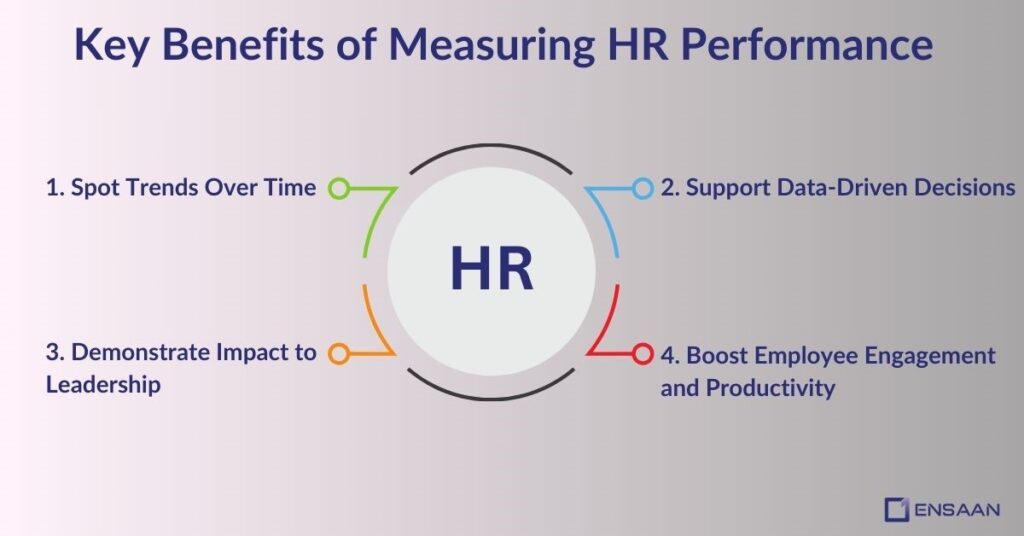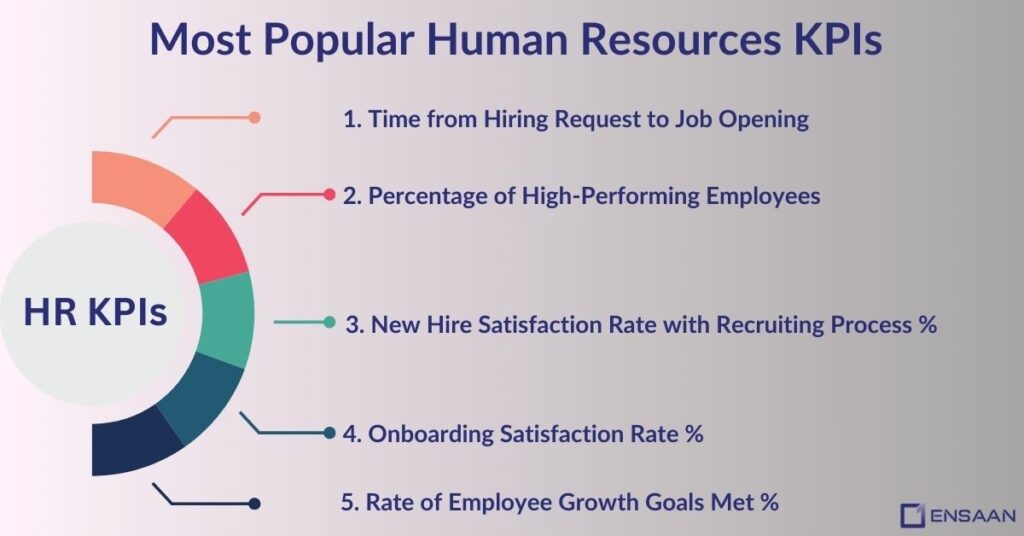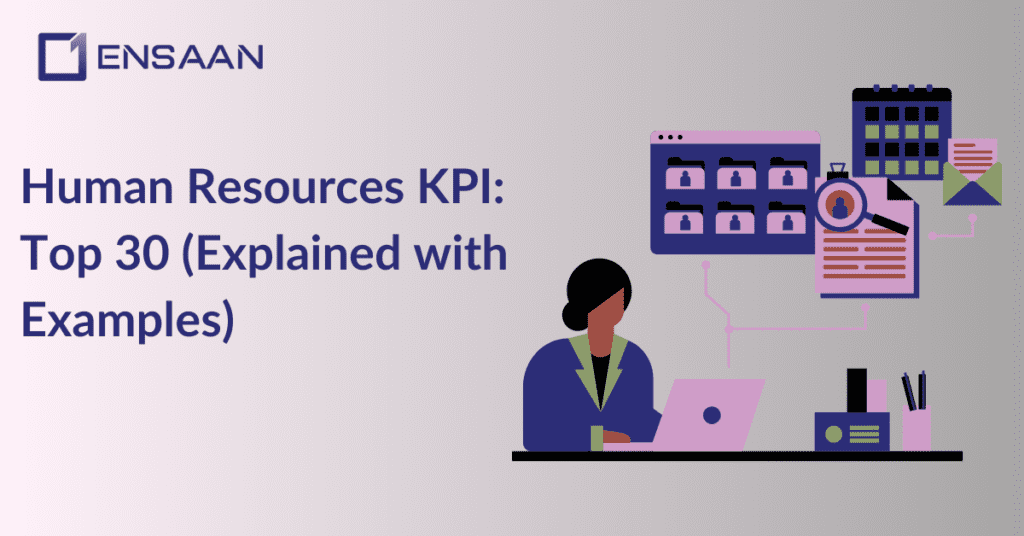Human Resources (HR) departments play a vital role in protecting one of a company’s greatest assets, its employees.
Success for any company relies heavily on employee performance, and HR helps motivate, retain, and maximize productivity among staff members.
HR uses KPIs (Key Performance Indicators) to measure its success, which are simple numbers that indicate where HR could make improvements and where work must continue.
This article will outline 30 crucial HR KPIs, why they matter and how HR software can make tracking them simpler.
By the end of it all, you’ll know how you can utilize these KPIs to make your HR team even stronger.

What Is HR KPI Metrics?
HR KPI metrics provide HR managers with a way to evaluate how effectively their department is functioning.
These indicators help identify areas for improvement, evaluate HR strategies’ success and guide data-driven decisions to streamline HR processes.
HR KPI metrics cover various areas, such as employee engagement, productivity, recruitment and retention.
Monitoring these metrics provides HR managers with invaluable insights that enable them to make more effective decisions and elevate organizational performance.
Examples of Common HR KPI Metrics:
- Employee Turnover Rate: Measures how many employees leave over a period.
- Time to Hire: Tracks how long it takes to fill a job position.
- Cost per Hire: Calculates the expense of recruiting a new employee.
- Absenteeism Rate: Monitors the number of days employees are absent.
- Training and Development Metrics: Measures the impact of employee training programs.
- Employee Engagement: Tracks how connected and motivated employees feel.
- Time to Productivity: Evaluates how long new hires take to become fully productive.
- Diversity and Inclusion Metrics: Measures diversity in the workplace.
- Employee Satisfaction: Tracks overall happiness and satisfaction among employees.
- Employee Retention: Measures how effectively the company keeps its employees.
Each KPI serves a specific purpose. For instance, employee turnover rate shows how effective recruitment and retention strategies are, while employee engagement highlights areas where employees may feel disconnected, prompting corrective action.
Why HR KPI Metrics Are Important?
KPI metrics for HR departments can provide invaluable insight into and improvements for their performance.
These experts assist organizations by helping identify weaknesses, assess current strategies and make necessary improvements that ensure efficient operation of their organizations.
Why Is Measuring HR Performance Important?
Measuring HR performance using KPI metrics is vital in order to ensure that the HR department supports overall business goals.
Human Resources plays an essential role in managing an organization’s most precious resource: employees.
Monitoring performance helps ensure employees are managed appropriately and contributes towards organizational success.
Key Benefits of Measuring HR Performance

Metrics provide a clear picture of what’s working well and where improvements need to be made in HR practices.
It helps optimize HR processes and enhance areas such as employee engagement, recruitment and retention.
1. Spot Trends Over Time:
Regularly measuring KPI allows HR professionals to identify patterns and trends.
For instance, an increasing employee turnover rate may signal issues that need attention such as workplace dissatisfaction or subpar hiring practices.
2. Support Data-Driven Decisions:
HR managers can use KPI data to make informed decisions rather than relying on assumptions. This ensures resources are allocated effectively to address critical issues.
3. Demonstrate Impact on Leadership:
Measurable data allows HR managers to justify their strategies and decisions to senior management, including how HR initiatives contribute directly to business outcomes, such as increased productivity or reduced costs.
4. Boost Employee Engagement and Productivity:
Monitoring performance helps HR establish strategies that increase employee happiness and productivity, leading to a more motivated and efficient workforce.
Top 30 Most Popular Human Resources KPIs

1. Time from Hiring Request to Job Opening:
This KPI measures how long it takes for HR to post a job after a department requests a new hire. It shows how quickly the HR team acts to fill staffing needs.
Why It Matters
Delays in posting job openings can slow down projects or affect overall business operations if teams are waiting for new employees.
This KPI helps assess how efficient and responsive the HR team is to the company’s needs.
How to Calculate
Formula:
Date job is posted – Date hiring request was made
Example
If it takes 5 days to post a job after a request, it shows the HR team is responding quickly.
2. Percentage of High-Performing Employees:
This KPI measures the percentage of employees who consistently exceed their performance goals.
It highlights the overall quality of talent in the company and can help predict business success.
Identifying these high performers is also useful for succession planning and developing future leaders.
Why It Matters
A higher rate of high-performing employees means the company has a strong workforce, which can lead to better results and growth.
Recognizing and nurturing these employees is important for long-term success.
How to Calculate
Formula:
(Number of high-performing employees / Total number of employees) x 100
Example
If there were 30 high performers out of 200 employees, the rate would be 15%.
3. New Hire Satisfaction Rate with Recruiting Process %
This measures how happy new employees are with their hiring experience, from applying to onboarding.
A positive experience can help new hires feel more welcome and engaged, while a negative one may lead to early departures or discourage future candidates.
Formula
(Number of satisfied new hires / Total new hires) x 100
Example
If 85 out of 100 new hires were happy with the process, the satisfaction rate is 85%. HR teams usually aim to improve this number.
4. Onboarding Satisfaction Rate %
This measures how happy new employees are with their onboarding, which includes orientation and initial training.
A smooth onboarding process helps new employees settle in faster and feel more productive, which can lead to higher job satisfaction and lower turnover.
Formula
(Number of new hires satisfied with onboarding / Total new hires) x 100
Example
If 80 out of 100 new hires were happy with the onboarding, the satisfaction rate is 80%.
5. Rate of Employee Growth Goals Met %
This shows the percentage of employees who have met or exceeded their personal career development goals. Meeting these goals increases employee satisfaction and engagement, and it reflects the effectiveness of training programs.
Formula:
(Number of employees who met their growth goals / Total employees with set growth goals) x 100
Example
If 120 out of 150 employees reached their goals, the rate is 80%.
Comprehensive List of Human Resources KPIs
Below is a selection of key performance indicators (KPIs) related to Human Resources (HR), each designed to assess and track various aspects of HR activities, employee satisfaction, performance monitoring and organizational efficiency.
Each KPI provides a brief explanation of its purpose and significance. By clicking any KPI, you can uncover more detailed descriptions – formulae, methods of calculation and real-world examples included!
Compensation & Benefits
- Average Overtime Hours per Employee: Measures the average number of overtime hours worked by employees within a set period (monthly/annually).
- Average Paid Time Off: The average number of paid days off employees take (e.g., vacations, personal days) annually.
- Benefit Utilization Rate: The percentage of employees using specific benefits provided by the company.
- Satisfaction with Salary and Benefits: A metric based on employee feedback about their satisfaction with compensation and benefits.
Diversity, Equity & Inclusion
- Employees With Disability: The number or percentage of employees identified as having a disability.
- Gender Ratio: The proportion of male to female employees in the company.
- Promotion Rate by Demographic Group: Measures promotion rates within different demographic groups (e.g., gender, ethnicity).
- Rate of Staff from Minority Ethnic Groups: The percentage of employees from minority ethnic backgrounds.
- Rate of Women in Management Positions: The percentage of women in leadership or managerial roles.
Employee Engagement & Development
- Employee Issue Resolution Rate: The percentage of employee issues that are resolved within a certain timeframe.
- Learning Sessions Held for Top Management: The number of learning/training sessions for top leadership.
- Promotion Rate: The percentage of employees promoted within a given period.
- Rate of Employees with Development Plans: Percentage of employees with documented personal development plans.
- Rate of Managers Trained in Key Processes: The percentage of managers trained in critical organizational processes.
- Rate of Monthly 1-on-1 Meetings for All Staff: Percentage of employees who have regular 1-on-1 meetings with their managers.
- Time to Answer Employee Suggestions: The average time taken to respond to employee suggestions.
- Training Completion Rate: The percentage of employees who complete training programs.
Employee Performance & Satisfaction
- Employee Feedback Action Rate: The frequency with which employee feedback leads to organizational changes.
- Employee Satisfaction Score: A general measure of employee satisfaction, typically gathered via surveys.
- Rate of Employee Growth Goals Met: The percentage of employees who achieve their growth or development goals.
- Rate of Employees Who Would Recommend the Organization: The percentage of employees who would recommend their employer to others.
- Rate of High-Performing Employees: The proportion of employees who exceed performance expectations.
- Rate of Low-Performing Employees: The percentage of employees who consistently underperform.
- Rate of Performance Reviews Completed on Time: Tracks the timely completion of performance evaluations.
Employee Retention & Succession
- Employee Retention: The percentage of employees staying with the company over a set period.
- Employee Tenure Average: The average length of service for current employees.
- High-potential Employee Retention Rate: Retention rate of employees identified as having leadership potential.
- Involuntary Termination Rate: Percentage of employees terminated for reasons other than resignation or retirement.
- Job Leaving Ratio per Department: Percentage of employees leaving a specific department.
- Leadership Transition Success Rate: Success rate of leadership transitions, often measured by team/department performance post-transition.
- Rate of Employees Near Retirement Age: The percentage of employees nearing retirement age.
- Succession Readiness Rate: Percentage of critical roles with identified successors ready to step in.
- Voluntary Turnover Rate: The percentage of employees who leave the company voluntarily.
Holidays, Health & Safety
- Absenteeism Rate: The frequency of unplanned absences excluding approved leave.
- Average Sick Days Per Employee: The average number of sick days taken by each employee annually.
- Average Vacation Days Per Employee: The average number of vacation days taken by each employee annually.
- Employees Trained in First Aid: Percentage of employees trained in first aid.
- Medical Leave Frequency: Tracks how often employees take medical leave.
- Number of Accidents: Total number of workplace accidents within a given period.
- Participation in Voluntary Health Screening: Percentage of employees
- Participating in voluntary health screenings.
- Safety-related Incident Rate: Measures the frequency of safety-related incidents in the workplace.
HR Operations & Budgeting
- Administration Cost per Employee: The average cost incurred by the HR department per employee for administrative tasks.
- Average Cost of Training per Employee: Average amount spent on training each employee.
- Average Response Time for Routine HR Inquiries: Measures the average time it takes for HR to respond to routine inquiries.
- Cost of Office Space per Employee: The average cost of office space allocated per employee.
- HR Budget Utilization Rate: Percentage of the HR budget utilized over a given period.
Recruitment & Onboarding
- Actual vs. Budgeted Cost of Hire: Compares the actual cost of hiring new employees to the projected cost.
- Average Cost to Recruit per Job Position: The total cost incurred in recruiting a specific job role.
- Average Days of Vacancy Duration by Function: The average number of days a job vacancy remains open.
- Average Sourcing Cost per Hire: The cost associated with sourcing each new hire.
- Average Time from Job Acceptance until Job Start: The time between a candidate accepting the job and starting the position.
- Days From Employment Request to Job Opening: Time taken from identifying a staffing need to the job vacancy announcement.
- Job Offer Acceptance Rate: The percentage of job offers accepted by candidates.
- New Hire Satisfaction Rate with Recruiting Process: Employee satisfaction with the recruitment process.
- Onboarding Satisfaction Rate: Measures new hires’ satisfaction with their onboarding experience.
- Rate of Applicants Referred by Current Employees: Percentage of applicants referred by current employees.
- Time to Hire: Average time from the job vacancy announcement to the selection of a candidate.
Remote Work
- Active Remote Working Agreements: Total number of employees with agreements for remote work (full-time/part-time).
- Remote Technology Utilization Rate: Frequency of use of tools and technologies designed for remote work.
- Remote Work Satisfaction Rate: Satisfaction level of employees who work remotely.

Conclusion
HR KPIs (Key Performance Indicators) are essential tools for measuring the success of HR departments and overall employee satisfaction.
HR managers can gain invaluable insights by monitoring these metrics, such as recruitment, employee engagement, retention and productivity.
These insights assist in making data-driven decisions to enhance business results.
KPI gives HR operations and potential areas for improvement a clear view. From employee turnover rates to training completion rates, these KPI give managers an accurate snapshot of HR operations.
Implementing the right HR software can make monitoring and improving KPI much simpler and more efficient, leading to a more productive, engaged, and satisfied workforce.
Choosing the best HR software in UAE, Dubai ensures seamless integration, compliance with local labor laws, and optimized HR processes for better business outcomes.
FAQ
An HR KPI is a measurable metric used by the HR department to evaluate the performance of HR processes, like recruitment, employee satisfaction, training, and retention.
HR KPIs help identify strengths and weaknesses in HR operations, allowing for better decision-making and improvements in employee engagement, recruitment, and retention.
The turnover rate is calculated by dividing the number of employees who leave the company by the average number of employees during a period, then multiplying by 100.
HR software automates the tracking of KPIs, making it easier for HR teams to collect, analyze, and report data, thus improving efficiency and decision-making.
Employee satisfaction rate measures how happy employees are with various aspects of their job, such as compensation, benefits, work-life balance, and workplace culture.








